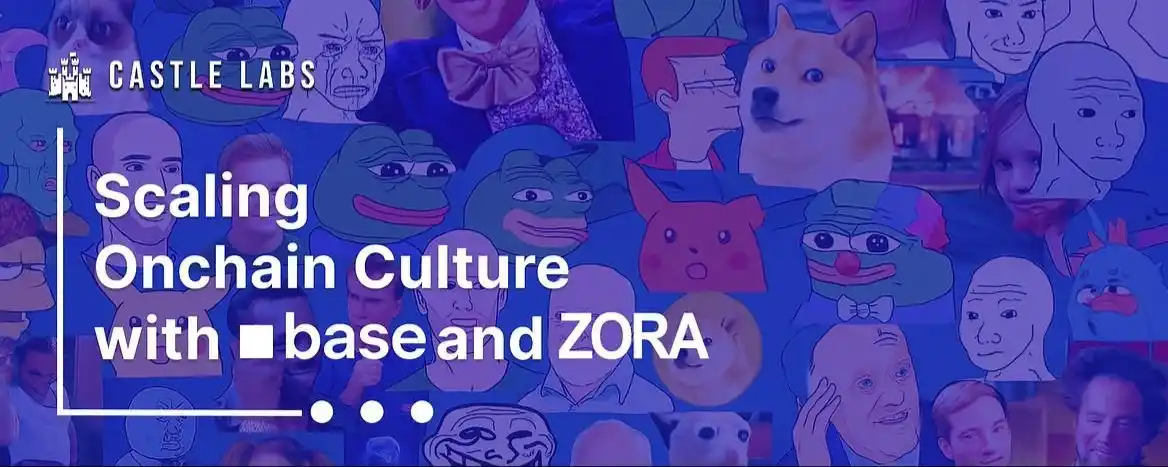
Original Title: "Scaling Onchain Culture with Base and Zora"
Original Author: @sakshimiishra, Castle Labs
Original Translation: BlockBeats
Editor's Note: Coinbase CEO Brian Armstrong's purchase of Balaji's creator tokens on the Zora platform has once again brought Zora and content tokens to the forefront of market trends.
The fundamentals of the Zora network are strong, with its token price stabilizing in the range of $0.115–$0.12, and on-chain content creation and distribution activities remaining high. Driven by the dual forces of Base App integration and a resurgence in market interest, Zora's potential as a core experimental ground for the "content economy" is becoming increasingly evident. Next, we will delve into the recent development trajectory of Zora and Base from three perspectives: market trends, on-chain activities, and ecological evolution.
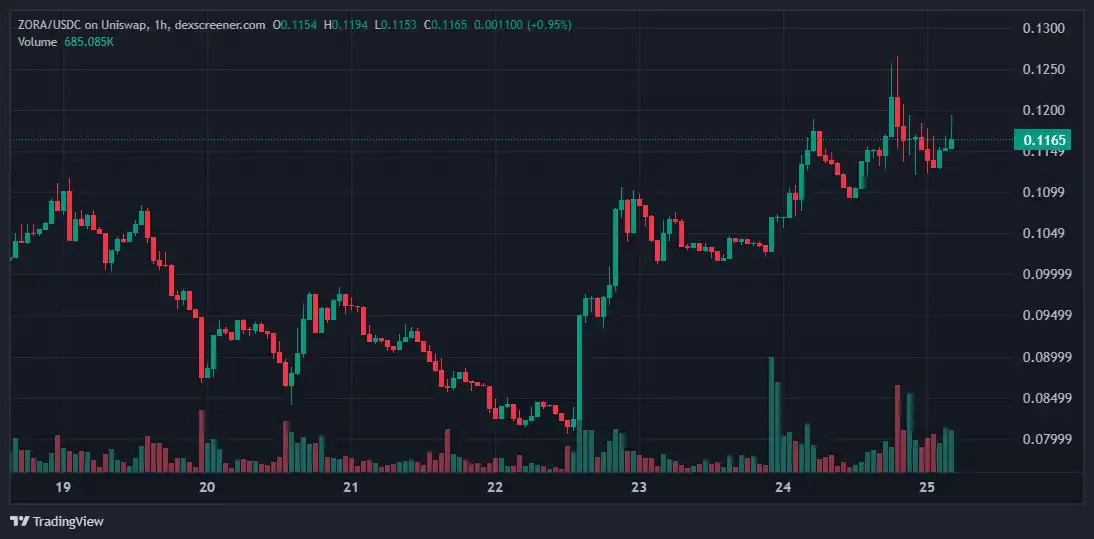
Over the past year, the Layer 2 track has seen fierce competition, but Base has successfully broken through, attracting over $4.9 billion in locked value and nurturing a rich ecosystem of DeFi, NFT, and rapidly growing SocialFi applications.
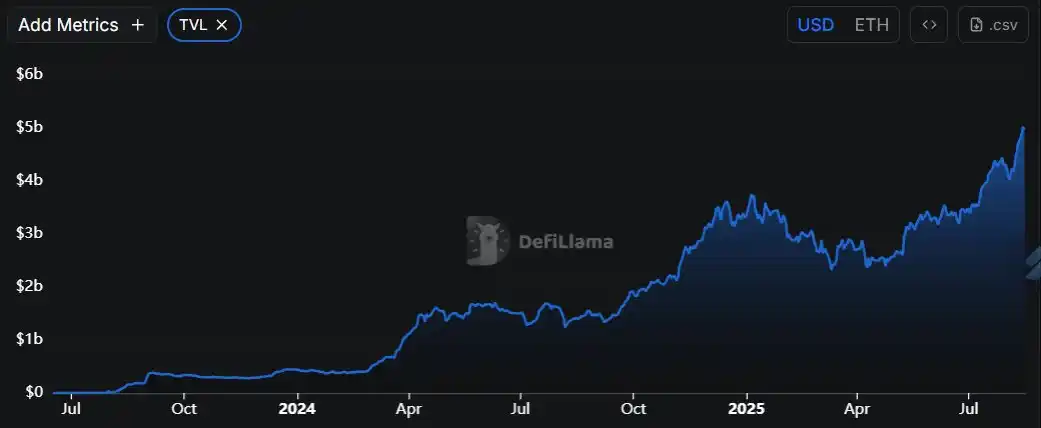
However, for Base, TVL is just the tip of the iceberg. Its focus is actually on "crypto culture."
This strategy is beginning to yield results, as the number of tokens issued on Base recently surpassed that of Solana, largely thanks to Coinbase's transformation of its wallet into the Base App, a crypto "super app" aimed at the creator economy.
Through deep integration with SocialFi platforms like @Farcaster_xyz, @Zora, @Clankeronbase, and mini-apps like @noicedotso, the Base App transforms social content into tradable on-chain assets, reshaping the ways creators monetize and communities interact.
This is the path of on-chain cultural expansion that Base and Zora are jointly promoting.
Base Brief History
Base is a Layer 2 blockchain built by Coinbase on the Optimism OP Stack, aimed at making Ethereum faster, cheaper, and easier to use.
As of mid-2025, Base has achieved:
· 24.4 million monthly active addresses
· Peak of 161.92 TPS
· Over 276 million transactions in the past 30 days, far exceeding most L2s
· An active ecosystem composed of DeFi, NFT, and SocialFi projects
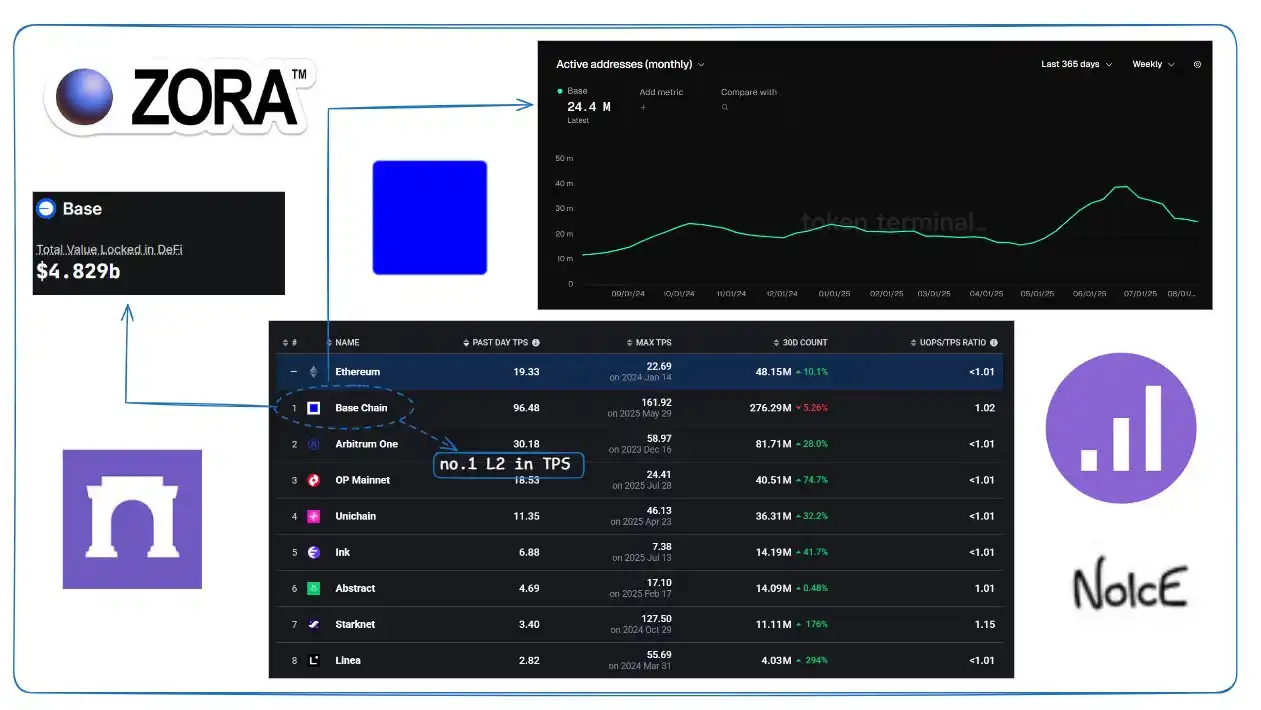
Additionally, events like "Base Onchain Summer" further indicate that Base aims not only to scale Ethereum but also to lay the infrastructure for millions of creators and communities to enter Web3.
Base App: From Infrastructure to Cultural Hub
As Base transitions from a mere blockchain infrastructure to a "cultural hub," it places the creator economy at its core. In July 2025, the new version of the Base App launched, marking not just a rebranding but also an upgrade from single-chain support to a complete ecosystem empowering developers, creators, and everyday users globally, allowing them to monetize directly on-chain and own their creations.
Coinbase's vision for the Base App is clear: to create a "super app" for the crypto world.
Core features of the Base App include:
· Wallet
· Social feed
· Payments
· Mini-apps
· AI Assistant

You can think of it as Apple Pay + decentralized social media. Once users log in, the system automatically generates a smart wallet, eliminating the need for cumbersome mnemonic phrase backups.
What is a Smart Wallet?
A smart wallet is a self-custodial on-chain wallet based on Passkey, directly embedded in the App, emphasizing "seamless onboarding." No browser plugins, no frequent app switching, resulting in a smoother experience.
The real highlight of Base lies in its SocialFi integration. By embedding platforms like Zora and Farcaster, Base is attempting to break the traditional Web2 platforms' control over creators, allowing them to truly own their content.
The Flaws of the Web2 Creator Economy
In the Web2 world, creators face tough choices:
· Subscription model: Requires continuous output, lacks personal touch, and locks content behind paywalls.
· Advertising: Only meaningful with a large audience, severely impacting user experience.
· Tips: Fragmented and unsustainable, making it hard to support long-term creation.
Worse still, the platform economy heavily favors the platforms. As shown in the image, platforms like TikTok, Instagram, and X take 85-95% of the value, leaving creators with only 5-15%. Even YouTube's relatively "better" 55/45 split still hands nearly half of the revenue to the platform.
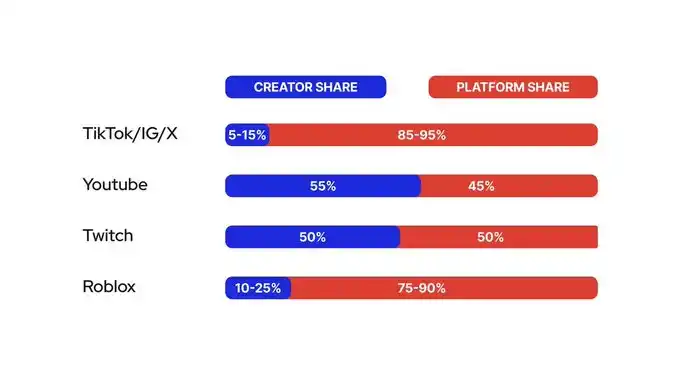
This severe imbalance is precisely what Base's new SocialFi strategy aims to change. The social layer operates on Farcaster, where posts can be instantly minted into tradable ERC20 tokens via Zora.
Tokenizing content is a simple yet powerful idea.
Every post, image, or video can be minted as a tradable ERC-20 token, referred to as "Content Coin." This transforms social media interactions into liquid, ownable assets, creating new monetization avenues for creators and allowing fans to directly participate in the success of the content.

In addition to direct trading, mini-apps like Noice also support tipping.
As of now, the total amount tipped on Noice has exceeded $250,000, becoming another source of income for creators.
Creators can also earn through:
· Transaction fees from Content Coins (0.5%)
· Retaining 1% of Content Coin shares, which they can sell
· Weekly reward distributions: For example, at the end of July, the Base App distributed $10,000 USDC to over 2,900 accounts.
Base's Creator Reward Mechanism
On the Base App, every post is minted as a "Content Coin," with a fixed total supply of 1 billion coins. Of these, 10 million coins (1% of the total supply) are directly allocated to creators, allowing them to have ownership from the start and earn when their content gains popularity. Meanwhile, there is also a "Creator Coin," which is tied to individual profiles and can serve as a tradable asset representing the creator's value.
The entire incentive model is encoded in smart contracts and executed automatically through fee sharing, with all Content Coin transactions incurring a 1% fee, of which:
· 0.5% goes to the creators
· 0.3% goes to referrers (0.15% to transaction referrers, 0.15% to content creation referrers)
· 0.2% goes to the Zora protocol
To date, this mechanism has brought creators over 3,500 ETH in rewards.
Trading of Creator Coins is conducted through Uniswap V3 liquidity pools, allowing users to buy and sell instantly. However, insufficient liquidity remains a challenge for many small and medium creators. Compared to traditional platforms (like X, which takes over 85% of revenue), Zora's system allows creators to retain over 50% of the value, along with more additional profit opportunities.
Zora differs from previous attempts in that it adopts a "content-first" model. Instead of simply turning creators into "meme coins," it directly binds tokens to the content they create, such as images, text, or videos. When a creator uploads an image, they can name the corresponding token, allowing it to directly reflect the content itself. This design allows the value of the token to transcend mere speculation, becoming more intrinsic and closely linked to the creator's expression.
Some of the applications already integrated into the Base App include:
· Zora: Provides content tokenization features, allowing users to convert social media posts (such as text, images, and videos) into tradable ERC-20 "Content Coins," with automatic access to Uniswap liquidity pools. Creators receive 10 million tokens for each post and enjoy a 1% share of transaction fees, making Zora the core of content minting and monetization.
· Farcaster: As a social infrastructure, it offers a decentralized user interaction protocol, including posting and commenting. It integrates with the Base App to provide a platform for sharing and interacting with tokenized content.
· Clanker: An AI-based tool for quickly issuing meme coins through Farcaster. Users can create ERC-20 tokens on Base by simply @clanker on Farcaster, leveraging its social integration to promote community-driven token discovery and deployment.
· Noice: A Farcaster Mini App focused on tipping and interaction, serving as a traffic entry point for the Farcaster economy. It enhances user engagement through content tipping, complementing Zora's tokenization features and Farcaster's social layer. Noice's influence was highlighted at the Base TBA conference by its founder.
How they work together:
· The Base App combines Zora's tokenization technology with Farcaster's social protocol, enabling users to create, share, and trade tokenized content.
· Clanker simplifies the token creation process through Farcaster's social channels, while Noice enhances interaction through its tipping feature.
This combined effect drives the formation of network effects, continuously attracting creators and traders to join.
Base App as a Catalyst for ZORA
The integration of Base App and Zora has driven a surge in ZORA's price and on-chain activity, with significant growth in both trading volume and the number of active creators. This momentum is also attributed to the clever operations of the community. Under the leadership of Base founder Jesse Pollak, coordinated Farcaster promotions and grassroots marketing have attracted thousands of new creators and traders.
The data speaks for itself:
· The number of daily active independent creators on Zora surged from 2,000 on July 16, 2025 (the day before the Base App launch) to 22,500 on July 27.
· ZORA has increased by 600% in the past 30 days, gaining visibility and liquidity due to its listing on Binance. Its all-time high reached $0.14, with a rise of up to 1400%.
· On August 4, the number of tokens issued on Base reached 51,575, surpassing Solana's Pump.fun (only 4,173), marking the first time since early 2023 that a chain has exceeded Solana in daily token issuance.
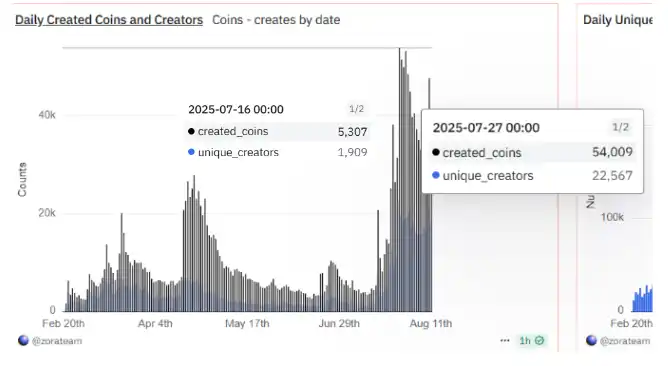
Coinbase's brand and influence are also amplifying Zora's growth, from CEO Brian Armstrong's "Base Shake" meme coin to Pollak's frequent appearances on Farcaster, providing the community with ongoing reasons to "create, trade, and participate."
Risks: Speculation, Hype, and Limitations of the Model
As mentioned earlier, creators have four main ways to earn money, including selling the 1% of Content Coins allocated to them, but this has raised many questions, the most common being sustainability: is this platform building a long-term creator economy, or is it merely another speculative playground?
In April 2025, Zora airdropped 1 billion tokens to 2.4 million wallets. While intended to celebrate growth, many tokens were valued even below gas fees and lacked governance functions. Critics labeled it as "just for fun," arguing that it detracted from long-term value building.
The token distribution has also drawn attention:
· 38.9% to the team/treasury
· 26.1% to investors
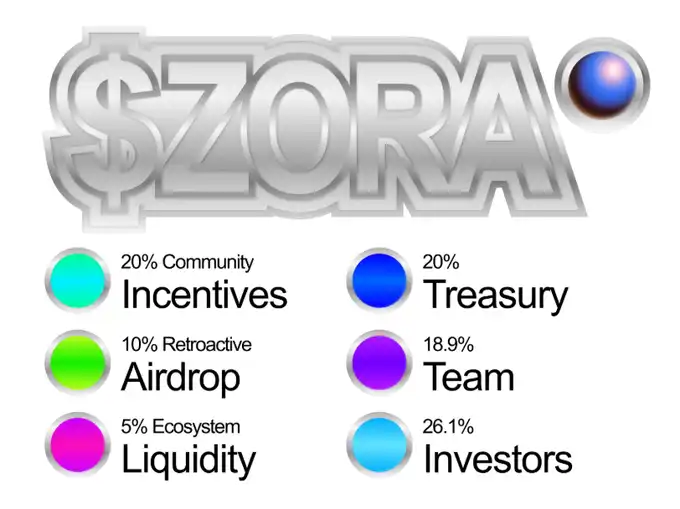
This highly concentrated holding structure has raised concerns about centralization, especially for a platform that claims to empower creators.
There has been much debate about the sustainability of the economic model surrounding the Base App.
One criticism describes Zora as a "super casino hell," arguing that Content Coins are more like meme coins without intrinsic value, with trading relying more on social hype than genuine content interaction. In this zero-sum game framework, Zora is seen less as a creator tool and more as a short-term speculative game.
After all, the creator model has already emerged in the NFT era and mostly ended in failure.
During this time, Solana co-founder Toly and Base founder @Jessepollak publicly engaged in a heated discussion on X.
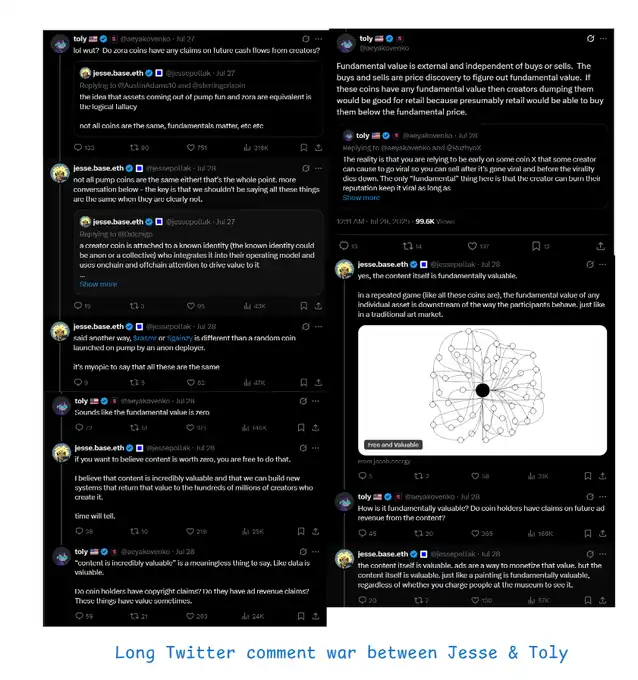
The summary of this "philosophical" debate is as follows:
Toly's Perspective
· Toly questioned the value of tokenizing social media posts on Zora, even sarcastically asking, "lol wut? Can tokens on Zora share in the creator's future cash flow?" He referred to these tokens as "digital trash," comparing them to speculative NFTs or blind box openings in mobile games.
· He argued that Zora tokens lack fundamental value because they do not grant holders any rights to the creator's future income (such as ad revenue), with their value entirely based on speculation.
· Toly even suggested that if Jesse truly believes in their intrinsic value, Coinbase should buy these "virtually worthless" tokens to prove their financial utility.
Jesse's Response
· Jesse emphasized that content itself has intrinsic value, much like art, and should not be measured solely by immediate monetization. He argued that Zora's tokens, through their integration with the Base App, can redistribute value to creators, with their "fundamentals" linked to creator activity.
· He portrayed Zora as an "infinite game," where community-driven actions continuously create systemic value, not just speculative trading, thereby empowering millions of creators.
User Reactions are Divided
· Some criticized Toly's stance as hypocritical, given that Solana itself is also immersed in the meme coin narrative.
· Others viewed this as a clash of blockchain ideologies: Base emphasizes the creator economy, while Solana leans towards the speculative market.
However, beyond the philosophical debate, the Base App itself has exposed some concerning issues:
· Sharp decline in trading volume: Trading volume plummeted in the first week of August, dropping from a peak of $550 million to $77 million (source: TokenTerminal).
· Lack of transparency: Issues such as suspected insider wallet trading and opaque information disclosure have severely damaged trust. Zora's "Ethos" page has also received negative feedback, further affecting community sentiment.
· Poor user experience: Users generally complain about the slow posting speed of the Base App, leading to a poor user experience.
· Content moderation controversy: Last week, the top token on the Base platform was surprisingly from a pornographic website, sparking widespread criticism (source: Decrypt).
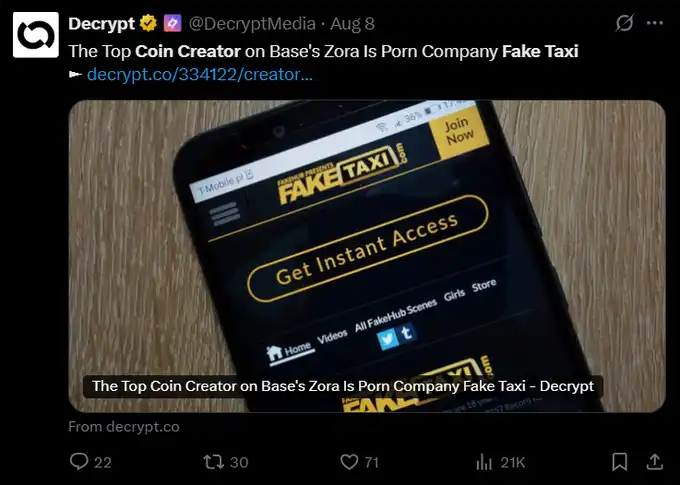
However, supporters argue that this is just a cycle that any blockbuster product must go through. At least for now, their judgment is not without reason: in the second week of August, ZORA's market momentum accelerated again.
The trading volume that had dropped sharply within days quickly rebounded in the second week.
Smart money and large funds began to flow in, driving ZORA to rise 46% in a single day, reaching an all-time high of $0.14.
Recent iterations of the platform are also ongoing, including "comprehensive acceleration" and performance improvements on the Android side.
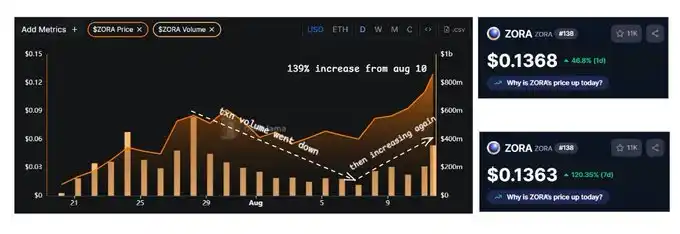
The real question moving forward is: can Zora's model emerge from the shadow of speculation, establish long-term trust, and achieve scalable expansion without diluting its core narrative of "on-chain creator ownership"? Or will it ultimately be seen as another "rebranded meme coin platform"?
Future Path and Imagination Space
Despite ongoing controversies, Zora is still in its early stages but has the potential to reshape the value system and monetization logic of digital content.
Currently, it has gathered over 421,000 creators and nearly 3 million collectors, and has achieved seamless scaling based on Base's OP Stack. Coupled with Coinbase's large user base, the future penetration space should not be underestimated.
Several noteworthy trends include:
· Deeper integration with Farcaster, strengthening the "social + economic" integrated interaction.
· Launching the Coins SDK to lower the development threshold for developers in the Content Coin model.
· Mobile-first expansion targeting global markets, entering regions where creator monetization is not yet fully realized.
Conclusion: A New Layer of On-Chain Culture?
Base initially served as a faster, cheaper Ethereum L2 technical solution. However, with the development of the Base App, it is shifting towards a grander positioning: the economic layer of culture, creativity, and community. Through this transformation, Coinbase is also clearly signaling a move from a centralized exchange to a more decentralized Web3 infrastructure.
Base's market strategy is clear: build infrastructure → attract creators → enable on-chain culture to self-compound. Zora plays a core role in this: turning content into tokens and creators into stakeholders.
Risks still exist. The hype will eventually fade, building trust takes time, and the speculative nature of content tokens may attract some while deterring others. Centralized token distribution and transparency issues are also challenges that must be faced.
However, if Zora and Base can refine their model, enhance user experience, and achieve better alignment in their incentive mechanisms, they indeed have the opportunity to reshape digital ownership.
An unresolved question remains: will content tokens become the next evolution in creator monetization, or will they ultimately be just another experiment in the lengthy history of crypto industry hype?
免责声明:本文章仅代表作者个人观点,不代表本平台的立场和观点。本文章仅供信息分享,不构成对任何人的任何投资建议。用户与作者之间的任何争议,与本平台无关。如网页中刊载的文章或图片涉及侵权,请提供相关的权利证明和身份证明发送邮件到support@aicoin.com,本平台相关工作人员将会进行核查。




